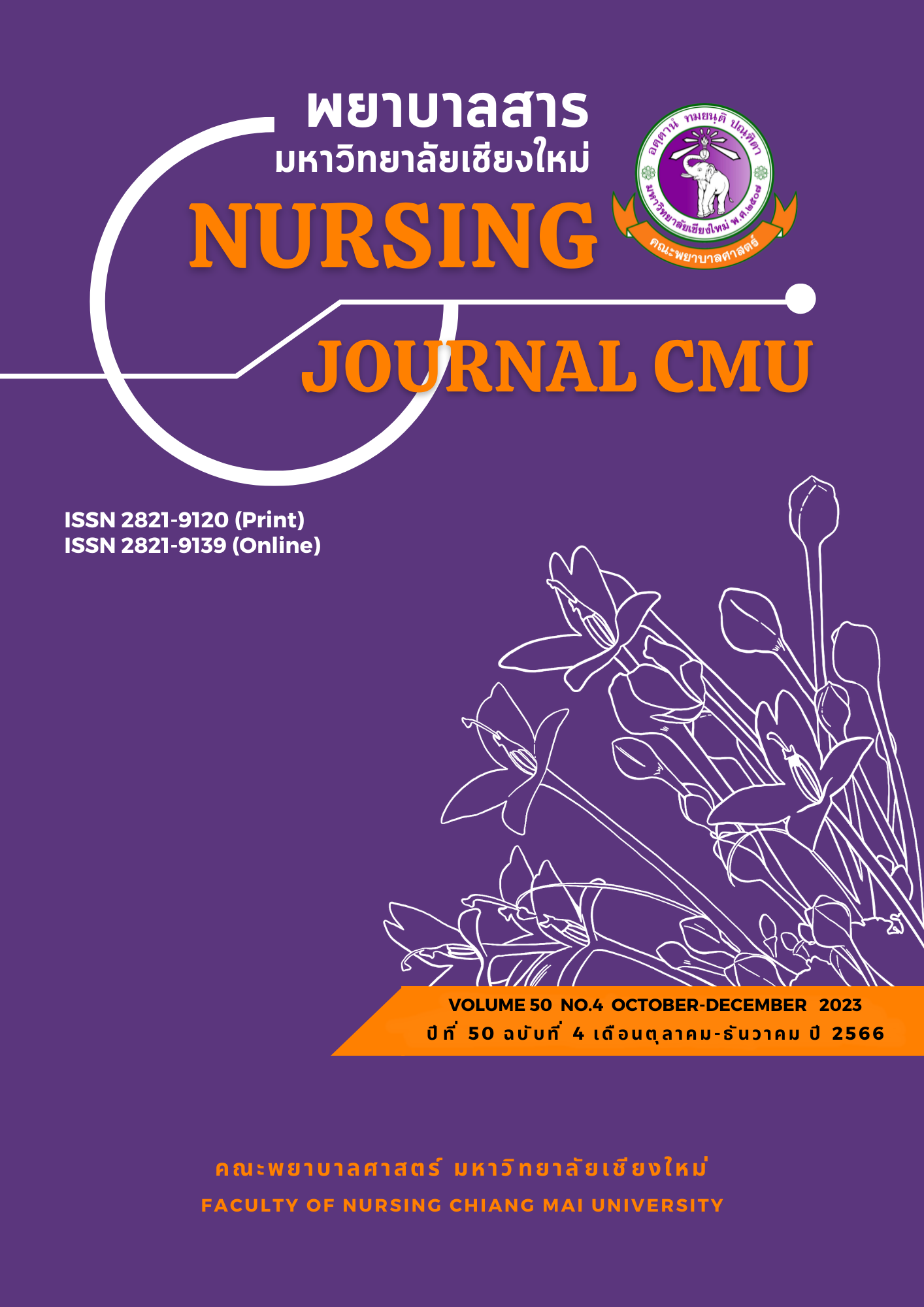Pain Experiences and Management Among Persons with Stroke
Keywords:
Pain experience, Pain management, StrokeAbstract
Persons with stroke have physical limitations and residual disabilities. Pain has been found to be an important problem, affecting patients in many aspects. The objectives of this descriptive research were to study pain symptoms and management, and its outcomes among persons with stroke. The participants consisted of both males and females, 3-12 months after a stroke, who were purposively selected. Research instruments included: 1) a general and clinical data record form, and 2) a pain experience and management interview form. Data were analyzed using descriptive statistics.
The results demonstrated that the 3 most frequent characteristics of pain symptoms that participants experienced were 1) cramping, 2) dull pain, and 3) aching. Cramping was managed using non-steroidal anti-inflammatory drugs, Thai massage, and opioid drugs. The results of these methods showed that pain could be relieved. Management of dull pain involved participants applying non-steroidal anti-inflammatory drugs, opioid drugs, and Thai massage, and these methods could relieve participants’ pain perception. The management of aching included applying non-steroidal anti-inflammatory drugs, and opioid drugs, and these methods could relieve pain perception.
The results of this study provide basic information for nurses and health care providers to use for providing suggestions regarding pain management or alternative appropriate care for managing pain symptoms in persons after stroke and their caregivers.
References
Akakun, T. (2000). Research methodology in behavioral sciences and social sciences. UbonRatchathani Rajabhat University. (in Thai)
Chakraborty, S., Basu, R., Jana, A. K., Banerjee, M., & Sanyal, D. (2016). Prevalence of post stroke depression in male and female patients visiting a rural hospital outpatient. International Journal of Innovative Research in Medical Sciences, 1(6), 294-302. (in Thai)
Chartsuwan, J., Peanpadungrat, P., Itharat, A., & Panichakarn, N. (2017). Comparative study on efficacy of physiotherapy and physiotherapy combined with Thai massage on rehabilitation outcome and quality of life of ischemic stroke patients with hemiplegia. Thammasat Medical Journal, 17(3), 356-364. (in Thai)
Dodd, M., Janson, S., Facione, N., Faucett, J., Froelicher, E. S., Humphreys, J., Lee, K., Miaskowski, C., Puntillo, K., Rankin, S., & Taylor, D. (2001). Advancing the science of symptom management. Journal of Advanced Nursing, 33(5), 668-676.
Dromerick, A. W., Edwards, D. F., & Kumar, A. (2008). Hemiplegic shoulder pain syndrome: Frequency and characteristics during inpatient stroke rehabilitation. Archives of Physical Medicine and Rehabilitation, 89(8), 1589-1593.
Finnerup, N. B., Haroutounian, S., Kamerman, P., Baron, R., Bennett, D. L. H., Bouhassira, D., Cruccu, G., Freeman, R., Hansson, P., Nurmikko, T., Raja, S. N., Rice, A. S. C., Serra, J., Smith, B. H., Treede, R. D., & Jensen, T. S. (2016). Neuropathic pain: An updated grading system for research and clinical practice. Pain, 157(8), 1599-1606. https://doi.org/10.1097/j.pain.0000000000000492
Hansen, A. P., Marcussen, N. S., Klit, H., Andersen, G., Finnerup, N. B., & Jensen, T. S. (2012). Pain following stroke: A prospective study. European Journal of Pain, 16(8), 1128-1136.
Harrison, R. A., & Field, T. S. (2015). Post stroke pain: Identification, assessment, and therapy. Cerebrovascular Diseases, 39(3-4), 190-201.
Kim, J. S. (2016). Post-stroke mood and emotional disturbances: Pharmacological therapy based on mechanisms. Journal of Stroke, 18(3), 244-255.
Oh, H., & Seo, W. (2015). A comprehensive review of central post-stroke pain. Pain Management Nursing, 16(5), 804-818.
Polit, D. F., & Hungler, B. P. (1999). Nursing research: Principles and methods (6th ed.). Williams & Wilkins.
Posai, V. (2021). Management of post-stroke pain. Biomedical Sciences and Clinical Medicine, 60(4), 841-854. (in Thai)
Prombut, P., Piaseu, N., & Sakulhongsopon, S. (2014). Factors related to stress of family caregiver of patients with stroke at home. Ramathibodi Nursing Journal, 20(1), 89-96. (in Thai)
Ruangritchankul, S., & Krairit, O. (2018). Chronic pain assessment in the elderly: Review article. Ramathibodi Medical Journal, 41(3), 92-99. (in Thai)
Sibbritt, D., Van Der Riet, P., Dedkhard, S., & Srithong, K. (2012). Rehabilitation of stroke patients using traditional Thai massage, herbal treatments and physical therapies. Journal of Chinese Integrative Medicine, 10(7), 743-750.
Tochaiwat, K., Predeekanit, K., Udom, T., Srisubat, A., & Thaiyakul, A. (2019). Massage therapy for spastic neurological patients: A systematic review. Ministry of Public Health, 44(1), 42-46. (in Thai)
Trompetto, C., Marinelli, L., Mori, L., Pelosin, E., Currà, A., Molfetta, L., & Abbruzzese, G. (2014). Pathophysiology of spasticity: Implications for neurorehabilitation. BioMed Research International, 2014, Article ID 354906. https://doi.org/10.1155/2014/354906
Widar, M., Samuelsson, L., Karlsson-Tivenius, S., & Ahlstrom, G. (2002). Long-term pain conditions after a stroke. Journal of Rehabilitation Medicine, 34(4), 165-170.
World Stroke Organization. (2017). World Stroke Organization (WSO) annual report 2017. http://www.worldstroke.org/assets/downloads/WSO_2019_Annual_Report_online.pdf
Downloads
Published
How to Cite
Issue
Section
License
Copyright (c) 2023 Nursing Journal

This work is licensed under a Creative Commons Attribution-NonCommercial-NoDerivatives 4.0 International License.
บทความที่ได้รับการตีพิมพ์เป็นลิขสิทธิ์ของวารสารพยาบาลสาร
ข้อความที่ปรากฏในบทความแต่ละเรื่องในวารสารวิชาการเล่มนี้เป็นความคิดเห็นส่วนตัวของผู้เขียนแต่ละท่านไม่เกี่ยวข้องกับมหาวิทยาลัยเชียงใหม่ และคณาจารย์ท่านอื่นๆในมหาวิทยาลัยฯ แต่อย่างใด ความรับผิดชอบองค์ประกอบทั้งหมดของบทความแต่ละเรื่องเป็นของผู้เขียนแต่ละท่าน หากมีความผิดพลาดใด ๆ ผู้เขียนแต่ละท่านจะรับผิดชอบบทความของตนเองแต่ผู้เดียว






